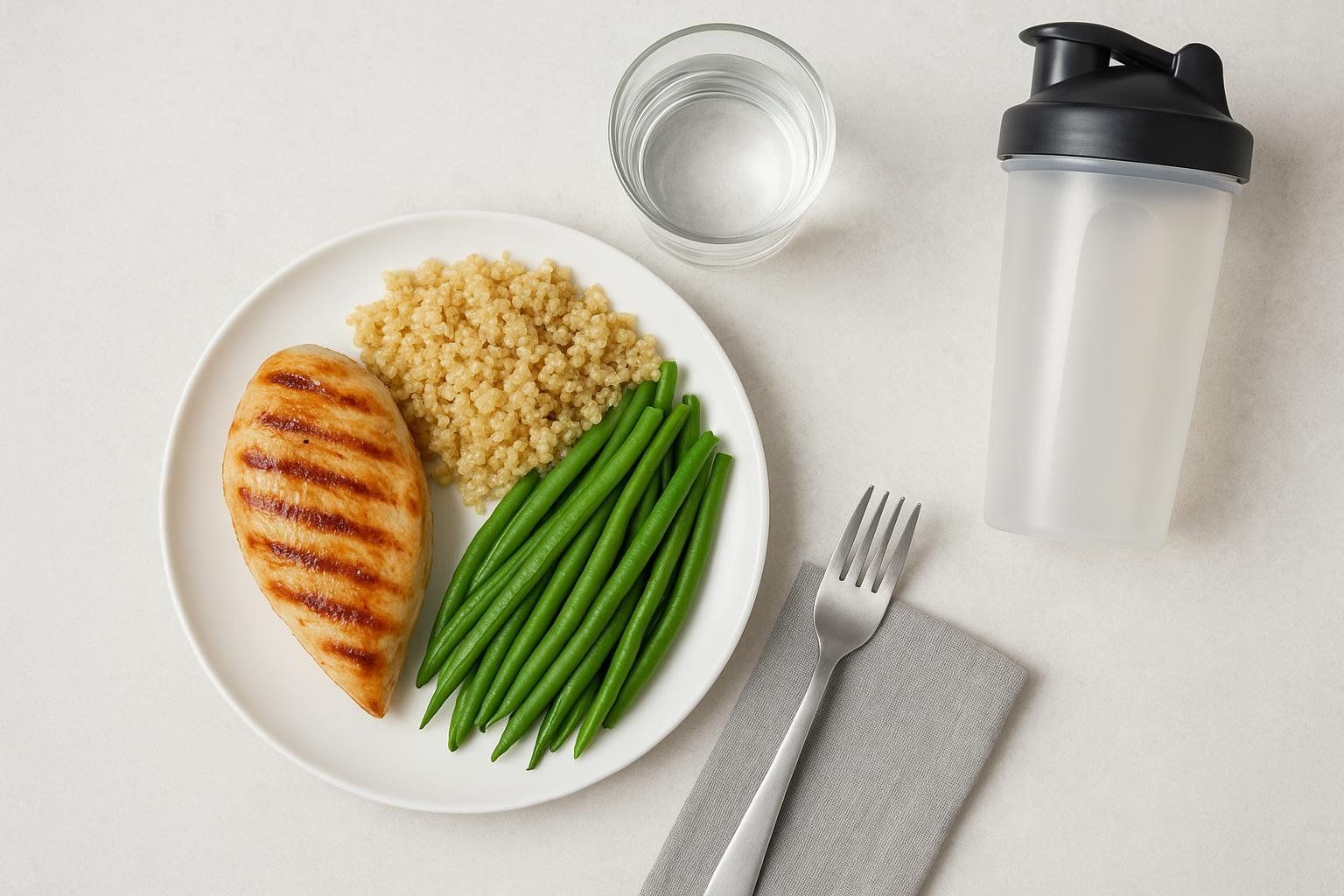Hybrid Training: Building Strength and Endurance Together

Hybrid Training: How to Build Strength & Endurance
Hybrid training blends endurance (aerobic) and strength (resistance) work in the same training week—sometimes the same day—to make you a more capable, resilient athlete. Done well, it improves stamina, power, and body composition without forcing you to choose one goal over the other.
The 30‑second answer:
- Yes, you can build strength and endurance at the same time. The “interference effect” is smaller than most people think when you plan recovery and session order smartly (Sports Medicine, 2021).
- Start with 3–4 days/week. Hit at least two full‑body strength sessions and two cardio sessions. Add days as recovery allows (AHA; ACSM).
- When pairing in one day, lift first. Or split AM/PM by 3+ hours to protect explosive strength (Frontiers in Physiology, 2023).
- Quick start plan: Mon full‑body lift + 10–15 min Zone 2; Wed intervals (6–10 × 1–2 min hard); Fri full‑body lift; Sat long easy cardio.
This guide covers how hybrid training works, how to manage interference, and provides weekly programs for every experience level.

What is hybrid training?
Hybrid training (also called concurrent training) is the purposeful combination of endurance and resistance training in the same program. Instead of specializing only in lifting or only in cardio, you build both engines at once.
Does it work? Good news—yes. A 2021 systematic review found that combining aerobic and strength training did not blunt muscle growth or maximal strength versus lifting alone; the only consistent tradeoff was smaller gains in explosive strength when cardio and lifting happen in the same session, which is reduced by separating sessions by ~3 hours (Sports Medicine, 2021). A 2023 meta-analysis also suggests any interference is small and context‑dependent (e.g., lower‑body strength in males), with similar VO₂max improvements across sexes (Nutrients Meta‑Analysis, 2023).
Interference effect, simplified (and how to avoid it)

- Why the myth exists: Endurance sessions can activate AMPK, a cellular energy sensor, which may temporarily down‑regulate mTOR, the pathway that drives muscle building.
- What long‑term studies show: When you program smartly, the impact on muscle size and max strength is minimal for most people; the main tradeoff is smaller gains in explosive power when you cram both into the same session (improved by spacing sessions).
- Split your sessions: Care about power or heavy lifting numbers? Separate cardio and lifting by ≥3 hours (or different days) to reduce fatigue carryover and protect explosive strength (Sports Medicine, 2021).
- Sequence matters (a little): In a combined workout, lift before cardio to bias lower‑body strength gains—especially helpful for women and older adults—while VO₂max gains are similar either way (Frontiers in Physiology, 2023).
- Respect recovery: Aim for 6–24 hours between hard strength and hard endurance work (AM/PM splits work great). Keep true hard‑hard pairings to 1–2 days/week.
How much of each? Weekly volume targets that work
Start with established health guidelines as a baseline, then adjust based on your goals:
- Cardio: At least 150 minutes/week of moderate intensity or 75 minutes/week of vigorous intensity (or a mix) as a health floor (AHA).
- Strength: Train all major muscle groups at least 2 days/week (ACSM).
For performance‑minded hybrid athletes, progress toward 2–4 strength sessions and 2–4 cardio sessions weekly. Control intensity with RPE and heart‑rate zones:
- Learn to use the RPE scale to autoregulate hard vs. easy days.
- Calculate your heart rate zones to train smarter.
Your Hybrid Training Templates
Pick the template that matches your time, equipment, and experience. Each includes strength‑ and endurance‑focused work, strategic recovery, and guidance on ordering and spacing.
3‑Day “Time‑Crunch” Template (Beginner)
- Day 1 – Full‑Body Strength (40–50 min)
- Squat or leg press — 3 × 8–12
- Romanian deadlift or hip hinge — 3 × 8–12
- Dumbbell bench press or push‑ups — 3 × 8–12
- Seated cable row or lat pull‑down — 3 × 8–12
- Plank or dead bug — 2–3 × 30–45 sec
- Finish with 10–15 min Zone 2 cardio
- Day 2 – Endurance Intervals (30–40 min)
- 6–10 × 1–2 min at Zone 4 with equal easy recoveries
- Optional: 2–3 core exercises (planks, leg raises, side planks)
- Day 3 – Full‑Body Strength + Zone 2 Cardio
- Strength (30–40 min)
- Front squat or goblet squat — 3 × 8–12
- Hip hinge (RDL or hip thrust) — 3 × 8–12
- Overhead press or incline DB press — 3 × 8–12
- Pull‑ups/assisted or lat pull‑downs — 3 × 8–12
- Carry (farmer’s walk) — 2–3 × 30–45 sec
- Then 25–40 min Zone 2 cardio (run/ride/row/hike)
- Strength (30–40 min)
Tips: Keep ≥24 hours between Day 1 and Day 2. If you must combine, lift first, cardio second.
4‑Day “Balanced Builder” Template (Intermediate)

- Day 1 – Lower‑Body Strength + Short Intervals (AM/PM if possible)
- AM Strength
- Squat — 3–5 × 3–6
- Romanian deadlift — 3–4 × 5–8
- Lunges — 3 × 8–10/leg
- Core (pallof press or hanging knee raise) — 3 × 10–12
- PM Intervals
- 6–8 × 400–800 m at 5k–10k pace; easy jog recoveries
- AM Strength
- Day 2 – Upper‑Body Strength
- Bench press or overhead press — 3–5 × 3–6
- Barbell rows or pull‑ups — 4–5 × 5–10
- Accessories (face pulls, triceps extensions, curls) — 2–3 × 10–15
- Day 3 – Active Recovery
- Mobility, walking, or easy spin (20–30 min)
- For guidance, follow our active recovery workout routine
- Day 4 – Tempo or Threshold + Hypertrophy (AM/PM if possible)
- AM Tempo
- 20–40 min continuous at comfortably hard pace (Zone 3–low 4)
- PM Hypertrophy
- Leg press — 3 × 10–12
- Hip thrusts — 3 × 8–12
- Lat pull‑downs — 3 × 8–12
- Dumbbell incline press — 3 × 8–12
- AM Tempo
5–6 Day “Performance Hybrid” (Advanced)
- Day 1 – Heavy Lower + VO₂ Intervals (AM/PM)
- AM: Heavy squats or deadlifts (3–5 × 3–5)
- PM: 4–6 × 3‑min VO₂ intervals with equal recovery
- Day 2 – Zone 2 Aerobic Base 45–90 min
- Day 3 – Heavy Upper + Sprints/Strides
- AM: Bench or overhead press, plus rows or pull‑ups (3–5 × 3–5)
- PM: 8–10 × 10–20 sec sprints with full recovery
- Day 4 – Rest or Very Easy 20–30 min + Mobility
- Day 5 – Full‑Body Strength (moderate volume) + Tempo 20–30 min
- Front squat — 3 × 6–8
- Romanian deadlift — 3 × 6–8
- Pull‑ups or lat pull‑downs — 3 × 8–10
- Dumbbell bench press — 3 × 8–10
- Loaded carries (farmer’s walk) — 3 × 30–45 sec
- Note: Use an AM/PM split if possible (lift first). Only combine if recovery allows.
- Day 6 – Long Endurance 60–120+ min (run/ride/row)
- Day 7 – Rest
Minimal‑Equipment Hybrid (Dumbbells + Bodyweight)

Perform these three workouts on non‑consecutive days each week (e.g., Monday, Wednesday, and Friday).
Day 1 – Strength Circuit (30–40 min)
- Complete 3–4 rounds. Rest 0–15 seconds between exercises. Rest 60–90 seconds after each full round.
- DB goblet squat — 8–15 reps
- DB Romanian deadlift — 8–15 reps
- Push‑ups — 8–15 reps
- 1‑arm DB row — 8–15 reps/side
- Split squats — 8–15 reps/side
- Plank — 30–45 sec
Day 2 – Conditioning (15–25 min)
- Choose one:
- 8 × 1 min hard/1 min easy run, bike, or row; or
- EMOM (Every Minute on the Minute) for 10–15 min: 8–12 dumbbell thrusters or 8–12 burpees each minute
- Optional 10–15 min Zone 2 cool‑down
Day 3 – Long Easy Cardio (40–60 min)
- Brisk walk, jog, ride, or hike
- Optional 5–10 min mobility flow
Fueling and Recovery for Hybrid Athletes

- Protein: Most lifters and hybrid athletes do well at 1.6–2.2 g/kg/day; total daily intake matters more than timing (BJSM meta‑regression, 2018).
- Carbohydrates (daily): Aim for 5–7 g/kg/day on moderate‑to‑high volume training days to replenish glycogen. Elite athletes on very high‑volume days may need 8–10 g/kg/day (Nutrients Review, 2018). For example, for a 150 lb (68 kg) person, this translates to:
- 5 g/kg ≈ 340 g carbs
- 7 g/kg ≈ 475 g carbs
- 8–10 g/kg ≈ 545–680 g carbs
- Carbohydrates (rapid post‑session): To speed up recovery, especially with two‑a‑day sessions, consume 1.0–1.2 g/kg/hour of carbohydrates for the first few hours post‑exercise (Nutrients Review, 2018).
- Post‑training window: Total daily intake drives most adaptation; however, protein and carbs within 0–2 hours post‑session can help with repair and refuel—especially with two‑a‑days or heavy blocks (Nutrients Review, 2018; BJSM meta‑regression, 2018).
- Creatine: Creatine monohydrate at 3–5 g/day is safe and effective for strength, power, and recovery; a loading phase is optional (JISSN review, 2021).

Sleep 7–9 hours, keep 1–2 easy days each week, and track readiness. For structured body‑recomp nutrition strategies, explore our body recomposition guide.
Track What Matters: Lean mass, fat mass, and visceral fat
Hybrid athletes care about performance and composition. A BodySpec DEXA scan quantifies fat mass, lean mass, bone density, and visceral fat so you can see if your plan is adding muscle where you want it and trimming the right kind of fat.
- Learn why DEXA is the gold standard for body composition tracking: BodySpec accuracy guide
- Understand why the scale can mislead: Body composition vs. weight guide
- Get scan‑ready in minutes: How to prepare for your BodySpec scan
Scan every 8–12 weeks to capture real changes while allowing time for adaptation. Use your reports to tune training load, distribution (cardio vs. strength), and nutrition. To keep your progress on track, use BodySpec DEXA scans every 8–12 weeks.
FAQs
Can you gain strength and endurance at the same time?
Yes. Meta‑analyses show concurrent training generally preserves hypertrophy and maximal strength while improving endurance; just separate hard sessions by ≥3 hours when possible to protect explosive strength (Sports Medicine, 2021). Sex‑specific analyses also suggest small, context‑dependent effects (e.g., lower‑body strength in males) but similar VO₂max responses across sexes (Nutrients Meta‑Analysis, 2023).
Should you lift before or after cardio?
If you combine in one session, lift first to bias strength gains—especially for lower‑body strength—while VO₂max gains are similar regardless of order (Frontiers in Physiology, 2023). If power is a priority, separate by ≥3 hours (Sports Medicine, 2021).
What’s the best hybrid split?
The “best” split is the one you can recover from consistently. Start with 3–4 days/week and advance to 5–6 as fitness and sleep allow. Use public health minimums as your floor (150 min moderate or 75 min vigorous cardio + 2+ strength days) (AHA; ACSM).
Will cardio kill your gains?
Not if you program intelligently. Long‑term studies show little to no negative effect on hypertrophy or maximal strength; the main risk is blunting explosive strength when cardio and lifting are crammed into the same session without recovery (Sports Medicine, 2021).
How should runners start lifting (or lifters start running)?
- Runners: Keep 2–3 strength days focused on heavy basics (squat/hinge/push/pull) plus calves and posterior chain. For a full walkthrough, see our strength training for runners guide
- Lifters: Build your aerobic base with Zone 2 work and 1 day of intervals weekly; learn pacing and zones in our heart rate zones guide. If you’re new to running, follow our 8‑week beginner 5K plan to progress safely.
Ready to go hybrid?
Choose the template that fits your life, set zones and RPE to guide intensity, and use clear feedback from your BodySpec DEXA scan every 8–12 weeks to confirm you’re gaining the right muscle and trimming the right fat.


